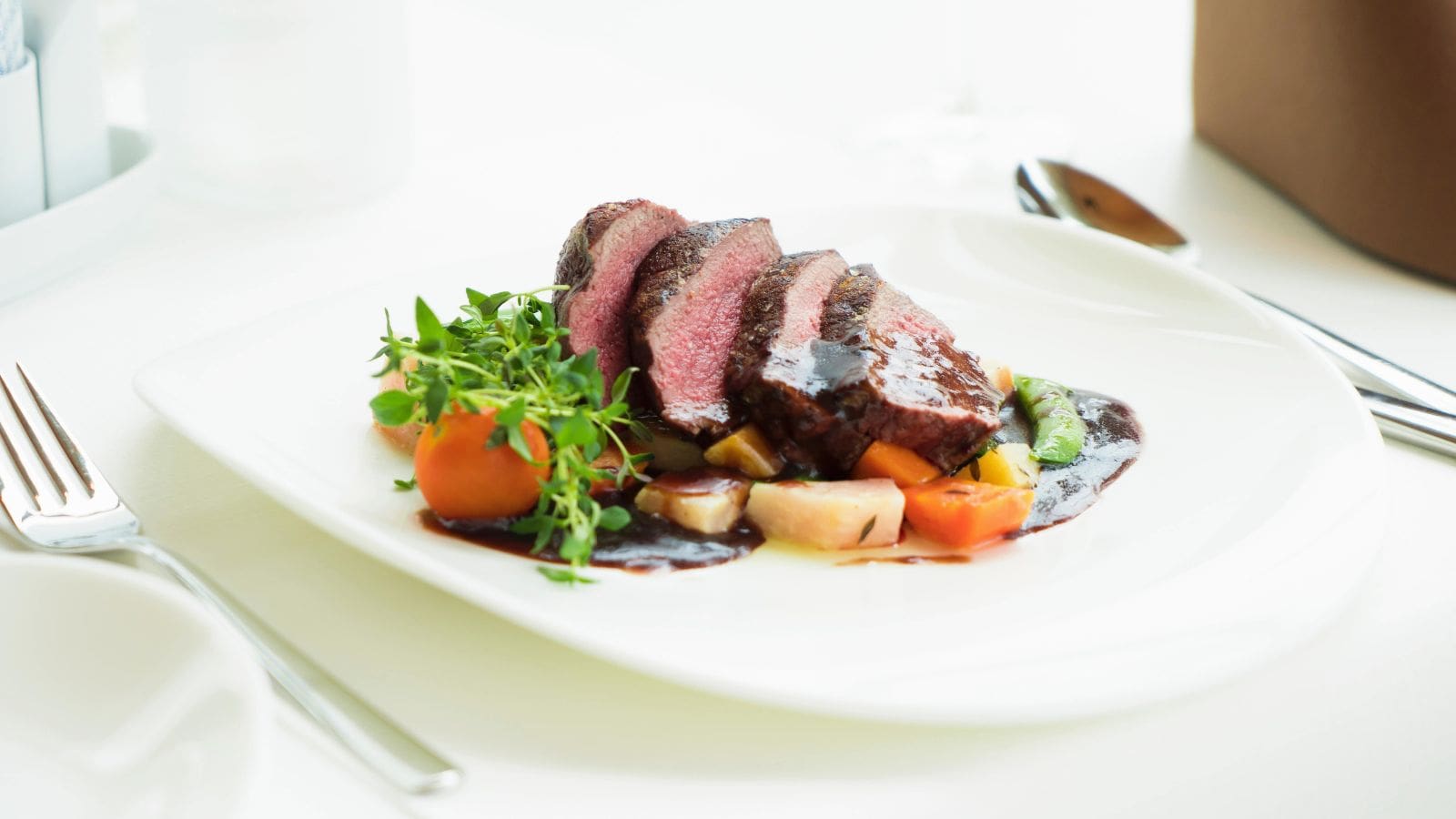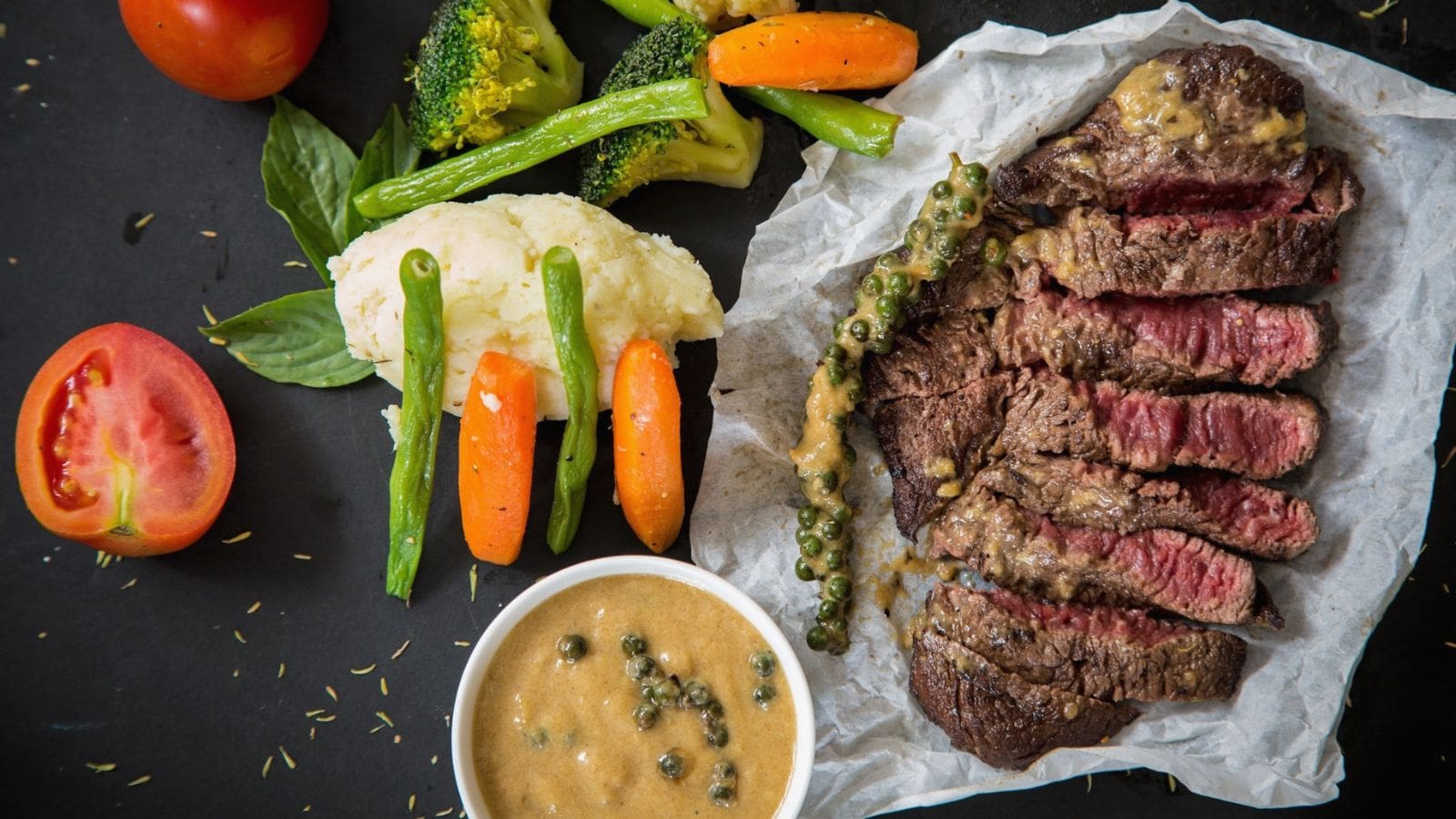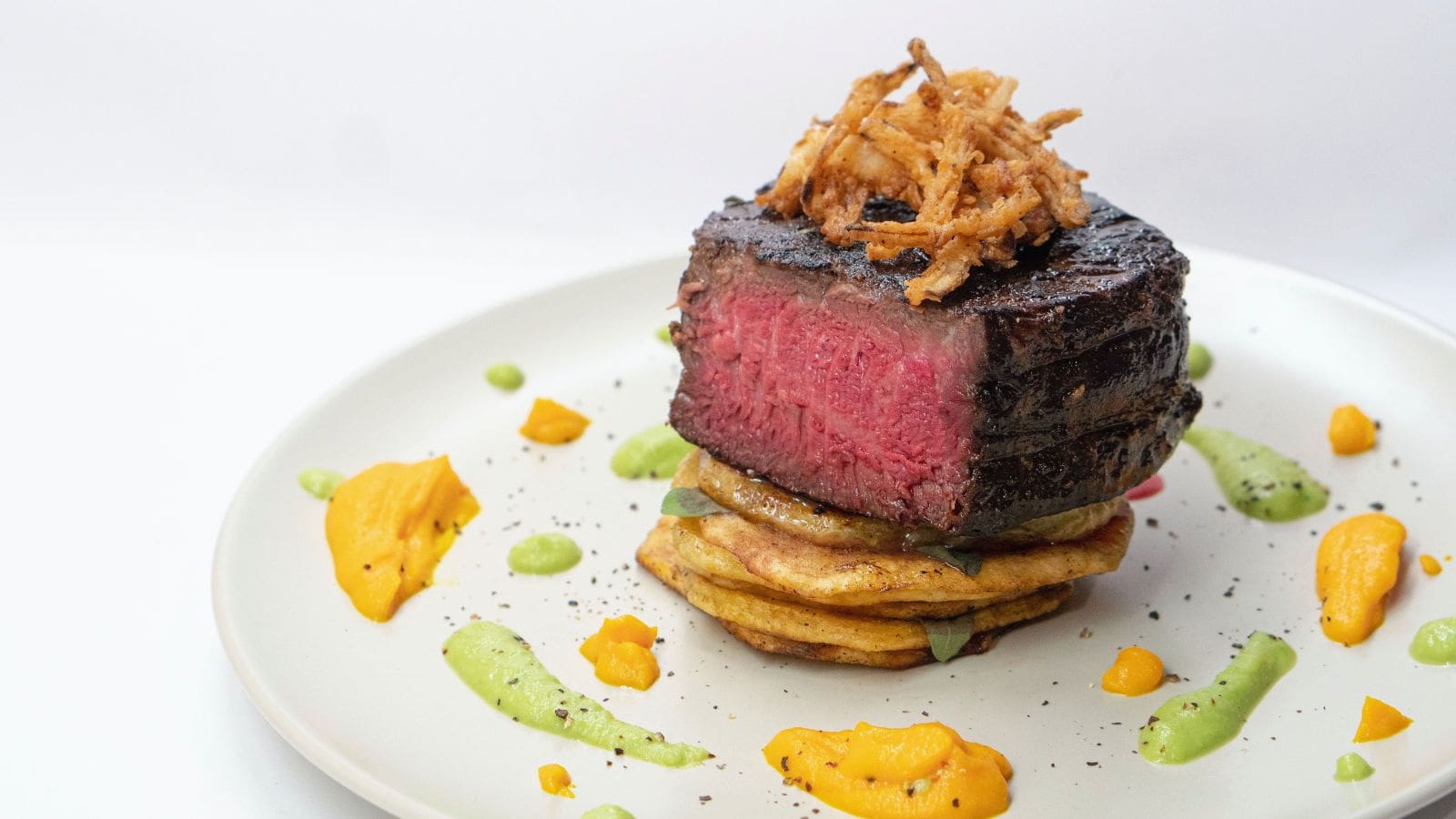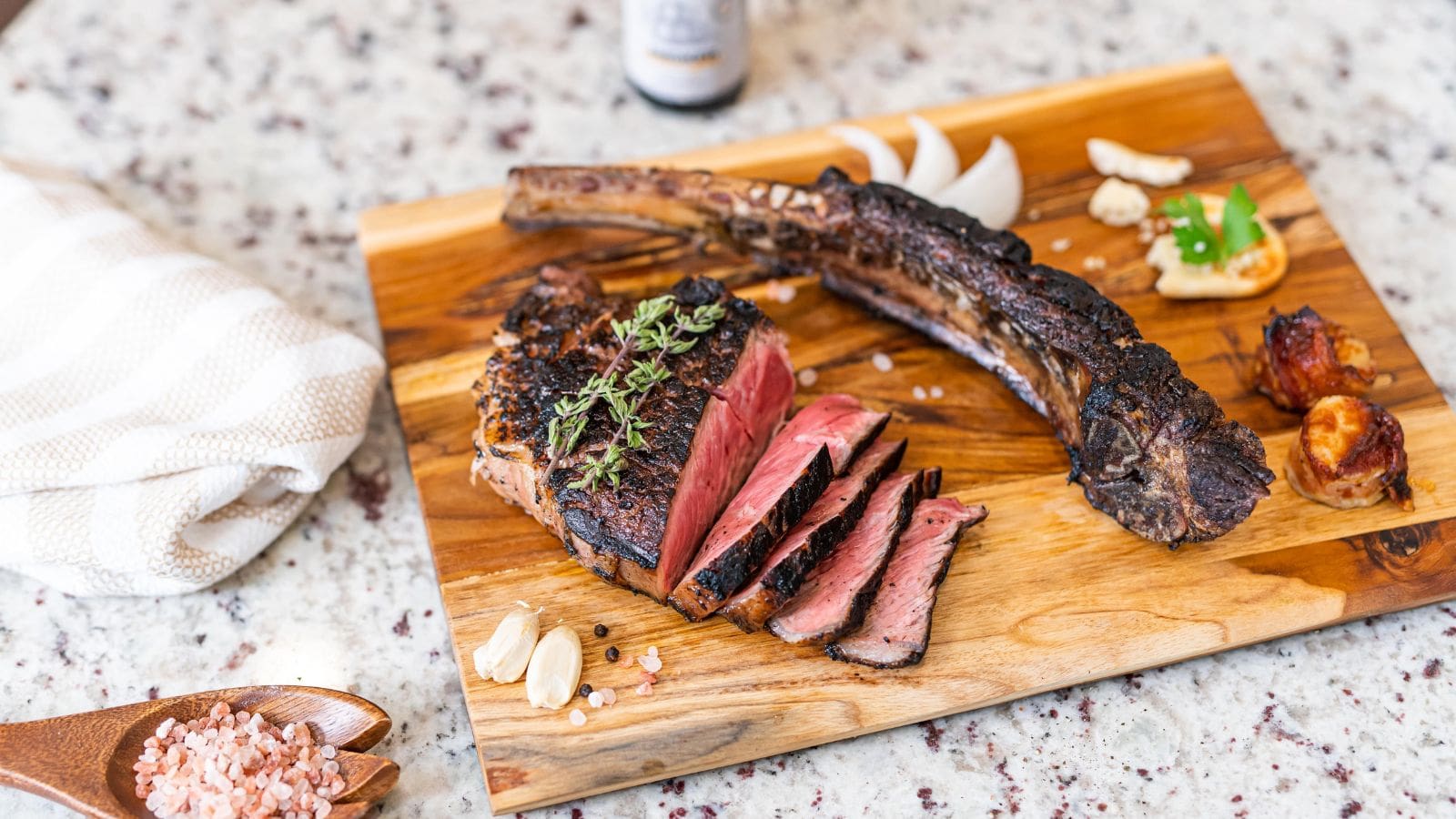Blue rare steak. What a mouthful that name is! Despite the complicated name, this is a food trend worth knowing about if you’re a meat lover.
Ordering your steak blue (also called “bleu”) is an increasingly common option in steak houses and restaurants. Considering it’s a level rarer than standard rare steak, you might think this option borders on raw. Below, we highlight why this isn’t the case.
Do you want to learn more about the infamous blue rare steak? Then, check out this ultimate blue steak guide.
Like reading about the blue rare steak? You might enjoy these posts too:
- 90 Affirmations for Losing Weight
- The Advantages and Disadvantages of Fast Food
- The Advantages and Disadvantages of JUNK Food
What On Earth Is Blue Rare Steak?
Blue steak is also sometimes called bleu or extra rare steak. It’s a steak that’s raw (or close to raw) on the inside and quickly seared on the outside.
A Primer to this Prime Cut
Due to quick, high-heat searing, this cooked cut of meat looks like a traditional steak on your plate. It’s not until you cut into it that you see the signature “blue” hue.
Like its rare counterpart, this steak has a cushiony texture and an incredibly meaty, “gamey” flavor. However, in extra rare steak, these experiences are even more pronounced.
Of course, since it’s cooked so quickly—typically just a few minutes on each side—it remains somewhat chilly in the middle. This makes for a steak that tends to divide diners; you either love or hate it.
Why is it called “blue” steak, you ask? A few theories exist, but none really hold up to scrutiny.
What’s in a Name?
The first theory concerns what happens when you slice your knife into a blue steak. Some say the meat looks blue at first. Then, after a few minutes of exposure to the oxygen in the air, it quickly turns a more familiar crimson red.
The reason often cited for that initial blue color is similar to how the veins in our body appear blue because they’re not exposed to oxygen. But when we cut ourselves, the blood that comes out is red.
But what comes out of a steak when you cut it is myoglobin. It’s not blood at all! And it’s also not blue.
Another plausible possibility is that raw meat tends to have an iridescent sheen. And, as this reflects the colors in the surrounding environment, it can sometimes appear blue. (Though more commonly, the colors reflected are green or orange-red.)
Or perhaps it was just a nicer-sounding way to describe a dish that some people find pretty unpalatable! Whatever the reason, one quick internet search proves the name is here to stay.

What Are the Origins of Blue Rare Steak?
Another less common name for blue rare is Pittsburgh rare. And the reason for this is because it’s believed the steak cooking style originates in this traditionally working-class American city.
The Pittsburgh Connection
As the story goes, Pittsburgh steelworkers had short lunch breaks. So they would order a steak charred on the outside and rare on the inside to ensure they still got to sit down and enjoy a hot midday meal. It was much quicker to cook that way!
Another possibly tall, possibly accurate tale purports that some surfaces in the steel factories—like super-heated air ducts—got so toasty that the workers literally cooked steaks on them for lunch. Finally, another source states workers used blowtorches to quick-charr their steaks and wolf them down.
Are any of these stories true, or are they simply fun-to-tell urban legends? It’s hard to determine!
It’s also complicated by the fact that the term “Pittsburgh steak” doesn’t always denote blue steak. Some diners use it to request a steak charred to a crisp on the outside, no matter what it looks like inside.
Other Potential Origins
Of course, since raw meat is popular in various international cuisines, from Japanese sashimi to French tartare, it’s hard to pinpoint the origins of this steak cooking method.
Raw or drastically under-cooked steak is considered a delicacy in many parts of the world. In Japan, for example, gyu tataki is a type of beef sashimi that’s seared briefly on the outside and marinated to make it even more tender and tasty.
Blue rare steak is sometimes confused with tartare, especially since the French word for raw is bleu. But they’re entirely different dishes.
Tartare is a French classic made from finely chopped raw meat. The meat is seasoned, topped with a raw egg, and served with specific accompaniments like toasted baguette and lemon wedges.
There is, of course, another possibility. Perhaps, as people sought out new culinary experiences, it was simply an inevitable progression from rare to blue.

Quick and Interesting Facts About Blue Rare Meat
Are you looking for blue meat facts to go? We’ve got you covered with this list below!
- The temperature of blue rare steak is around 115-120°F (46-49°C). That’s just above room temperature! Cooking time is minimal, typically less than two minutes per side.
- The color of blue rare steak can vary depending on the type of meat, the cooking method, and the temperature. In other words, it’s not necessarily blue!
- Some chefs use a blowtorch to sear the exterior of the steak quickly. This gives it that signature charred flavor and sizzling surface while the inside stays close to raw. Other cooks use a super-heated cast iron skillet or a grill to achieve the same effect.
- The texture of blue rare steak is often described as buttery or velvety. Enthusiasts believe it has a “melt-in-your-mouth” quality.
- Some advice sites claim that ordering a steak blue or rare can up your chances of winning a steak-eating competition or challenge. It’s easier to cut, chew, and swallow.
- However, you need a good quality steak knife to cut blue rare steak. Because it’s so tender and close to raw, cutting with the wrong implement can be challenging.
That’s it for the quick facts! If you want to dive deeper into this carnivores’ paradise, keep reading.
Why Do Some People Love Blue Rare Steak So Much?
There are a bunch of reasons why people claim to enjoy eating their steak ultra-rare. Most are, of course, anecdotal.
It’s More Tender and Juicy
So, this reason holds some (water) weight! All meat contains water—quite a lot of water, in fact. For example, a round roast has over 70% water content before cooking.
The longer and hotter a piece of meat is cooked, the more water evaporates out of the cut. In other words, it gets drier and less tender as time goes on.
Blue steak, cooked extremely quickly (though still at high heat), retains most of its water content. And this means it stays succulent.
Of course, the amount of water varies. Factors that affect water content in meat include:
- Type of muscle
- Kind of meat
- Season it was harvested
- The pH of the meat
High-end restaurants and top chefs consider all these factors when selecting cuts for the blue steak on their menu.
It Has a Higher Nutritional Value
Some believe blue rare steak has more nutritional value than its longer-cooked counterparts.
For example, proponents of the carnivore diet claim that sticking to a diet of predominantly (or even exclusively) meat aids weight loss, boosts mood, and regulates your blood sugar—not to mention stating you can get all the nutrition your body needs from meat, raw or otherwise.
It’s true that meat contains many essential nutrients for our bodies and is an efficient source of protein. It’s also true that some vitamins are lost during the cooking process. However, that’s not the whole story since cooking foods means some vitamins and other nutrients become more bioavailable.
So, as with most things in life, it’s more likely that a balanced diet that includes blue steak on occasion, rather than exclusively, is the healthiest option.
It’s More Environmentally Friendly
Some people consider blue rare steak more environmentally friendly because cooking it doesn’t take much energy. That’s probably a stretch, though!
Yes, chefs cook this type of steak far quicker than its less raw counterparts. But, with everything else on the plate, that won’t make much difference to overall energy use in a commercial kitchen.
Is It Safe to Eat Blue Rare Steak?
The short answer here is, “Yes, rare blue steak is safe to eat.” But there are a few caveats.
What Makes It Safe?
Most foods we eat are susceptible to infection by various pathogens—even packaged salad mixes have been linked to salmonella outbreaks!
Uncooked or undercooked meat is particularly at risk. The top contenders for contamination are:
- Salmonella
- Clostridium perfringens
- E. coli
- Yersinia
There’s more, but these are the primary concerns.
Most of the time, contamination happens through improper storage and cross-contamination. However, in some cases, meat cooked to a low temperature or for a short time can cause bacteria and other contaminants to proliferate.
When you cook a regular steak, let’s say, medium, you cook it long enough to kill the bacteria inside and outside. Of course, blue steak is cooked so quickly that some believe it could pose a risk to human health.
So what’s the key to cooking a safe blue steak? You need to sear every INCH of the outside of the steak.
This kills the bacteria on the outside of the steak. It also creates an impenetrable seal that ensures no bacteria can enter and infect the raw meat inside.
Who Shouldn’t Eat It?
Since blue rare steak needs to be cooked specially or it may pose (an albeit small) risk of foodborne illness, it’s not recommended for people with compromised immune systems or pregnant women.
But these people are also advised to avoid a wide range of raw or undercooked foods, from sushi and soft cheeses to raw eggs and pre-prepared vegetables.

Let’s Get Grilling! Cooking the Perfect Blue Rare Steak
So, you’ve decided that extra rare steak is the meat for you. Now, you just need to learn how to cook it properly to achieve that signature “blue” texture.
How to Cook It
First, let’s start with the heat method and equipment.
Most chefs prefer to cook steak in a frypan on the stovetop. This is typically over a flame (i.e., gas element), though an induction or electric cooktop can work well, too.
In terms of cooking equipment, there are a few essentials you’ll need.
First, you need a good quality heavy frypan. Many prefer cast iron because it holds a high heat. High-quality stainless steel can work well, too. You’ll also need something to flip the steak with, either tongs or a spatula.
Next, you’ll need to consider what you cook your steak in.
Rare blue shouldn’t be marinated—that defeats the purpose of enjoying the natural flavors of the meat. However, you’ll still need fat to cook in. Avoid butter because it has a low smoke point; instead, reach for a vegetable oil like canola, grapeseed, or even a good quality olive oil.
Lightly season your steak with salt and pepper.
Now, let’s take a look at the actual cooking steps:
- Heat the pan to around 400 F (204 C)—or a little over
- Once the pan is hot, place your steak on the pan
- Cook for 1-2 minutes until completely seared
- Flip and do the same on the other side
- Check all surfaces of the steak are seared
- If they aren’t, use your tongs to hold the un-seared portions to the pan
You can use the finger test to see if your steak has reached the desired doneness. For blue steak, that means it should feel like the fleshy area between the base of your palm and your thumb.
You can also check the internal temperature using a meat thermometer. It should be less than 84 F (29 C).
What To Serve It With
Some chefs serve blue rare steak with a cold sauce or dressing like mustard. They believe this balances the hot charred exterior and the cool raw interior.
Others choose a simple dusting of salt and pepper to bring out the natural flavors of the meat.
Alternatively, a blue rare steak may be served with a side of vegetables or starch, such as potatoes or rice. This aims to counteract the richness of the meat.
Blue rare steak is typically paired with bold red wines. They complement the meat’s rich flavor.
Get Eating!
Blue rare steak isn’t for everyone. Some find the “rawness” of the meat off-putting. But for diners who love juicy, tender, meaty cuts, this type of steak is a true delicacy.
Did you like this article about blue rare steak? Then, stay on the food train and check out this one about the advantages and disadvantages of junk food next!

